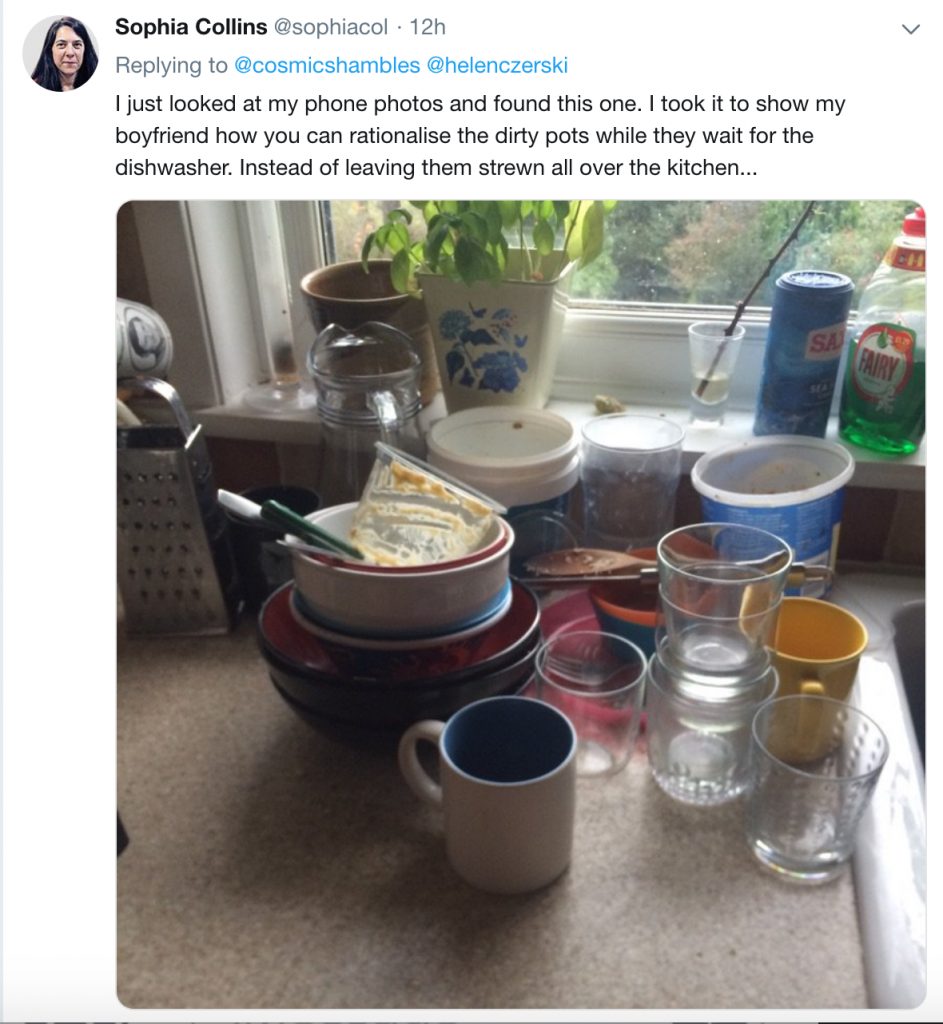Day 1 - Shambles Advent
Blog in a Teacup by Dr Helen CzerskiDay 1 – @sophiacol
There seems to be lots of grumpiness around at the moment, and lots of big-picture hero/villain, black/white, binary opinion stuff. A real lack of nuance. So every day until Christmas Dr Helen Czerski will be finding some cool, hidden science in pics of people’s every day lives in an attempt . To get involved, tweet your pic to @helenczerski and @cosmicshambles with the hashtag #ShamblesAdvent

Happy #ShamblesAdvent Day 1! This picture was sent by @sophiacol and I thought that a pile of washing up was the perfect way to start. It’s just the sort of sight that makes everyone a bit grumpier than they were before they looked, but it still hosts a hidden gem or two.
Here’s a question for you: why can you see those glass tumblers? They’re completely transparent and they have no colour. Shouldn’t they be invisible?
The fantastic thing about the tumblers is that you really can’t see them directly. For everything else in that picture, light hits the object, loses some of its original colours and then bounces into your eyes – that’s how we see. But the tumbler is transparent – light just goes straight through, and that light comes out the same colour that it went in. We can’t see it directly.
If you look at the dimples on the tumbler on the right, there’s a clue to what’s going on: a pair of dark and light patches making up each small dimple. Light bounces off the surfaces behind the glass and starts out on its way to your eyes. But as it passes from air into the glass, its path is bent slightly at the boundary (this is refraction), and then it’s bent back again on its way out. The same light reaches your eyes, but it’s been shunted sideways on its way. And the shunting depends on the shape of the glass. So what you’re looking at is everything behind the glass, but the light pattern has been distorted. You can’t see the glass itself, but you can see the effect of the glass messing up the scene behind it. Your brain recognises that an object must have been there to cause that distortion, and deduces there’s a glass there. So give yourself a pat on the back for being able to see the invisible. And let’s face it, washing up invisible things is far more fun, right?
The Cosmic Shambles Network relies on your support on pledges via Patreon so we can continue to provide great, new, exciting content without the need for third party ads or paywalls.
For as little as $1 a month you can support what we do and get some great rewards for doing so as well. Click the Patreon logo to pledge or find out more.
 Dr Helen Czerski is a physicist, first and foremost, but she’s acquired a few other labels along the way: oceanographer, presenter, author and bubble enthusiast. A regular on The Cosmic Shambles Network, she has also presented a number of acclaimed documentaries for the BBC and her first book, Storm in a Teacup, which looked at the physics of every day things, was a bestseller. Recently she was awarded the prestigious William Thomson, Lord Kelvin Medal and Prize from the Institute of Physics.
Dr Helen Czerski is a physicist, first and foremost, but she’s acquired a few other labels along the way: oceanographer, presenter, author and bubble enthusiast. A regular on The Cosmic Shambles Network, she has also presented a number of acclaimed documentaries for the BBC and her first book, Storm in a Teacup, which looked at the physics of every day things, was a bestseller. Recently she was awarded the prestigious William Thomson, Lord Kelvin Medal and Prize from the Institute of Physics.
If you would like to reuse this content please contact us for details
Subscribe to The Cosmic Shambles Network Mailing list here.



Aren’t reflections a major factor in making the glasses visible?
If you look straight through a (clean) window, you won’t see the window because there isn’t any refraction to affect the light.